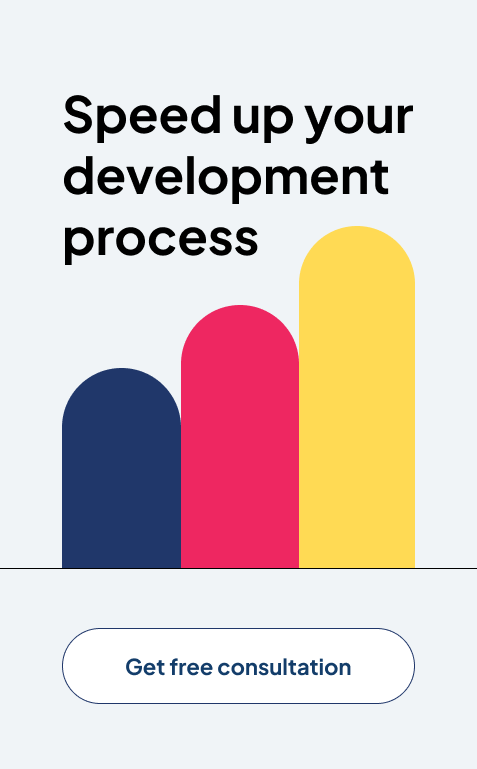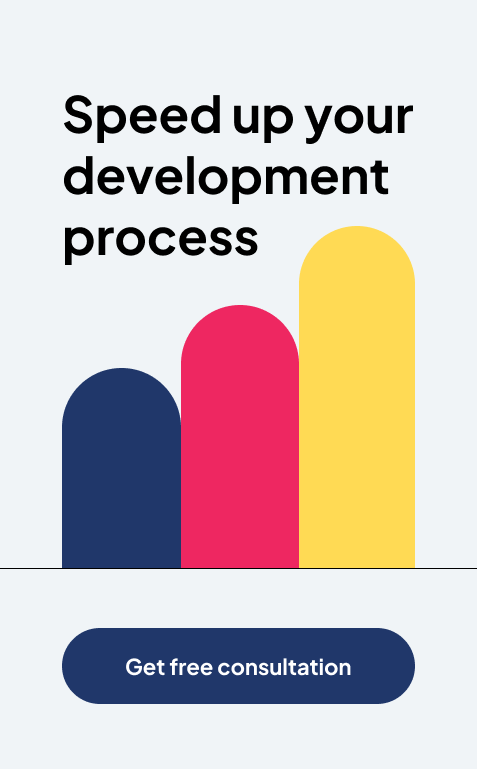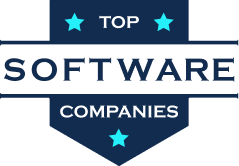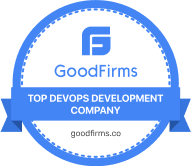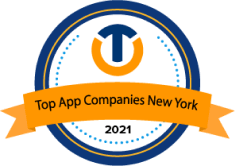Red Flags to Watch When Outsourcing Your MVP or Prototype

If you think it’s expensive to hire a professional, wait until you hire an amateur.
~ Red Adair
Planning to outsource your MVP or prototype in 2025? You must be looking forward to having intrinsic qualities in it. However, the internet is full of tech specialists offering specialized services to develop various MVPs or prototypes for your project.
Despite having a list of what your skills are to look for, expected outcomes, and other stuff, keeping an eye on RED FLAGS is very important!
So, did you figure out ways to navigate to the right professionals?
Not yet! No worries. Let’s learn how to spot red flags when outsourcing your MVP or prototype.
What Does A Suitable Outsourcing MVP Or Prototype Development Mean?
Since the global IT services outsourcing market is expected to grow at a CAGR of 7.7% from 2020 to 2027, there are plenty of options to navigate to skilled professionals globally. But, only you know who could be a suitable team for your MVP or Prototype development.
However, before that, you need to know what it means by a good outsourcing MVP or prototype?
A good MVP is more than mere coding. You need to understand the heart of the problem, your users’ experience, and figure out a solution!
A Good MVP’s Must-Haves
- Core Problem-Solving Feature
Focus on the one feature that solves the user’s main pain point. - Clear Value Proposition
Users should quickly understand what the product does and why it matters. - Target Audience Clarity
Built for a specific and well-defined early user group. - Simple and Intuitive UX/UI
Clean design with no distractions prioritizes usability over aesthetics. - Feedback Collection Mechanism
Built-in way to capture user feedback via forms, in-app prompts, analytics, etc. - Basic User Onboarding
A simple walkthrough or tutorial that shows how to use the MVP quickly. - Data Tracking & Analytics
Implement tools to track user behavior, conversions, drop-offs, etc. (e.g., Mixpanel, Google Analytics). - Scalable Architecture (if possible)
While lightweight, the MVP should be built on tech that can scale if validated. - Security & Privacy Basics
Even at the MVP stage, include essential protections for user data (e.g., GDPR basics, HTTPS). - Support or Contact Option
A basic help/support feature to engage with users or answer early issues. - Bug-Free Core Experience
The MVP can be rough around the edges, but the main flow must work smoothly. - Testing & Quality Assurance
Manual or automated testing for key flows to avoid breaking the core feature. - Lean Documentation
Simple notes for internal use: feature lists, assumptions, known bugs, and roadmap hints.
These are the elements of Must-Haves to consider in developing a suitable MVP!
How to Find the Right MVP Development Service?
Googling “MVP development service” might throw thousands of results your way, but choosing the right partner takes more than skimming websites. We’ve narrowed the process down to a proven formula that saves time, money, and sanity.
Here’s what you need to check before saying “Yes” while outsourcing an MVP or prototype development service!

1. Shortlist Smart: Not Just Anyone with a Dev Team
Start by narrowing your search to MVP development teams that:
- Specialize in your industry or product type.
- Have real reviews (not just glowing blurbs).
- Are responsive from the first contact.
- Show evidence of trust, transparency, and delivery.
| 💡 Expert Tip: Compare MVP services on platforms like Clutch, GoodFirms, and UpCity to see client feedback and verified projects. |
2. A Professional Website is A Green Flag
A sloppy website usually signals sloppy work. Your ideal partner should have:
- A clean, detailed site with case studies.
- Team bios, tech stacks, and service overviews.
- Recent awards or certifications, like Clutch Leader Awards.
| 📊 Interesting Fact 75% of users judge a company’s credibility based on website design. |
3. Look for Niche Experience, but Don’t Rule Out Newcomers
Prior experience in your domain is a big plus. But if you find a newer team that’s highly passionate and skilled, give them a fair shot. Just make sure to:
- Have a thorough discovery call.
- Evaluate their past work (even if limited).
- Ask how they’d tackle your MVP’s key challenges.
4. Ask for Real Testimonials and Referrals
Don’t just rely on polished reviews. Go deeper:
- Ask for direct referrals from past clients.
- Speak to founders who’ve worked with them.
- Look for patterns: delays, poor communication, scope creep.
5. Strong Communication Is Non-Negotiable
Agile development lives or dies by communication. Make sure your team:
- Provides regular updates (e.g., via Slack, Trello, or Jira).
- Is upfront about timelines, costs, and limitations.
- Asks smart questions that show real engagement.
6. They Have a Solid Project Management Process
No, project management system? Big red flag.
Because, Great MVP teams:
- Break projects into sprints with weekly check-ins.
- Involve you in every step.
- Adjust quickly based on feedback.
| 💡 Expert Tip: MVPs evolve. Choose a team that can pivot fast when user data rolls in. |
7. They’re Willing to Sign an NDA
Your idea matters, so protect it. The best MVP partners:
- Clearly define IP ownership.
- Offer to sign an NDA.
- Have security protocols for handling sensitive information.
8. Awards and Certifications Matter
Badges from platforms like Clutch, Web Excellence, or ISO aren’t just for show, they prove the team can deliver.
| 📌 Example: VeryCreatives was awarded Top Software Developer in Hungary 2023 by Clutch. |
9. Meet in Person (If Possible)
If you’re local or can travel, meet the team. In-person visits give you a real sense of:
- Company culture.
- Team energy.
- How seriously do they treat your project?
10. And Yes, Trust Your Gut
If the chemistry feels right, it probably is. Intuition matters more than founders admit. You’re building a relationship, not just hiring a vendor.
Red Flags to Watch When Hiring an MVP Development Partner
Do you know the startup failure rate is a whopping 90%? Hence, addressing warning signs during the outsourcing process is important. The hunt for an outsourcing MVP software development service that’s gonna fulfil your checklist isn’t easy, but also risky if you pick the wrong team.
Here are the biggest red flags that should make you stop and think before signing a deal.
-
-
Poor Communication Skills
If the team is slow to respond, doesn’t answer your questions clearly, or keeps changing what they say, it’s a bad sign. Building a minimum viable product needs fast feedback and clear updates.
→ Ask This: How fast do you respond to client messages? Can we have a single point of contact? -
No Clear Project Plan or Timeline
If the MVP development service can’t explain what happens week by week or skips planning calls, it shows they might not win it. That’s dangerous for startups.
→ Ask This: What does your development timeline look like? Do you provide weekly updates? -
Very Low Prices That Sound Too Good
Cheap rates might look tempting, but they often lead to messy code, missed deadlines, and rework. You may end up spending more fixing it.
→ Pro Tip: Check platforms like Clutch or GoodFirms for real reviews and pricing comparisons. -
No Proof of Previous MVP Work
If a company says they build MVPs but has no past projects, no screenshots, or no client stories, be careful. They might not have real experience.
→ Ask This: Can you show MVPs you’ve built for other startups? Have you worked in my industry before? -
They Refuse to Sign an NDA
A Non-Disclosure Agreement (NDA) protects your idea. If they say no to it, they may not take your project seriously, or worse, your idea might get copied.
→ Ask This: Are you okay signing an NDA before we discuss project details? -
Unclear Ownership of Code
If they won’t give you access to the source code—or say you need to keep paying them to keep the app running—that’s a big no.
→ Ask This: Do I fully own the code once the MVP is complete? -
They Don’t Ask You Questions
A good MVP development service wants to understand your vision, users, and goals. If they just take the specs and start coding, they may miss the point.
→ Ask This: How do you learn about a client’s product idea before starting? -
They Can’t Adapt to Change
Your MVP will likely evolve based on feedback. If the team is too rigid or doesn’t use Agile practices, you’ll get stuck.
→ Ask This: How do you handle feature changes during development? -
No Testing or QA Process
If there’s no mention of bug testing, user testing, or QA, you may get a broken product. Testing is a must, even for MVPs.
→ Ask This: What kind of testing do you do before delivery? -
Bad Reviews or No Reviews
No online presence, no reviews, or negative feedback from past clients? That’s a big red flag.
-
| Quick Tip Google the company with “scam” or “review” before committing. |
New-Age Smart Tips for MVP Outsourcing Success
Still, want more suggestions to reach to the best available options. These real-world tips can save you from serious MVP pain later.
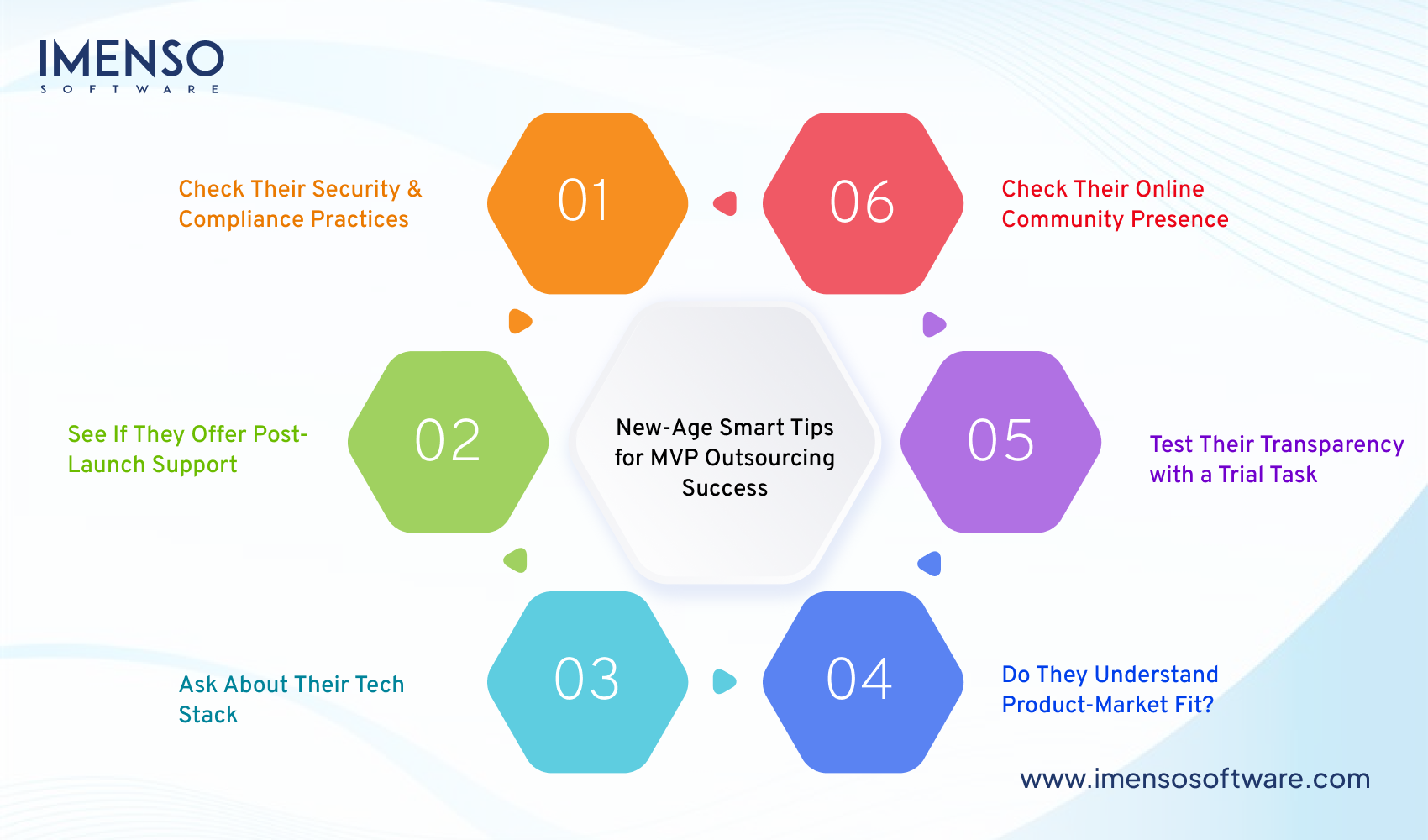
-
1. Check Their Security & Compliance Practices
If your MVP collects user data like emails, payments, or health information, data security matters. Many development teams skip this unless you bring it up.
| 🧠 Pro Tip Ask if they follow GDPR, HIPAA, or industry-specific security standards. Make sure your user data is protected from day one. |
-
2. See If They Offer Post-Launch Support
Some MVP services disappear once the app is built. But what if you hit a bug? Or want to add new features?
Smart Move: Choose a team that offers maintenance, analytics, and scaling support, not just build-and-go. -
3. Ask About Their Tech Stack
Not all tech is created equal. You don’t want your MVP built on outdated tools that make future upgrades hard or expensive.
Question to Ask:- What stack will you use for my MVP? Why is it best for my goals? -
4. Do They Understand Product-Market Fit?
A great MVP developer doesn’t just code, they help you validate your idea. If the team talks about solving real user problems, that’s a green flag.
Look for this: Are they asking about your users, feedback loops, or metrics? That means they care about more than just delivery. -
5. Test Their Transparency with a Trial Task
Still not sure? Start small. Ask them to build a quick landing page, feature mockup, or clickable prototype.
This helps you learn:- How fast they deliver?
- How they communicate?
- If they understand your vision.
A test run now can avoid a total mess later.
-
6. Check Their Online Community Presence
MVP development companies that contribute to GitHub, write blog posts, or answer questions on Stack Overflow are usually up-to-date and active.
Quick Hack: Search their company name on GitHub or Medium to see what they’re sharing.
What Should Be in a Great MVP?
An MVP (Minimum Viable Product) is not a watered-down version of your dream app. It’s a laser-focused tool to test your idea quickly, with real users, and at minimal cost. Here’s what your MVP must include and what it can skip:-
Must-Have Features in an MVP
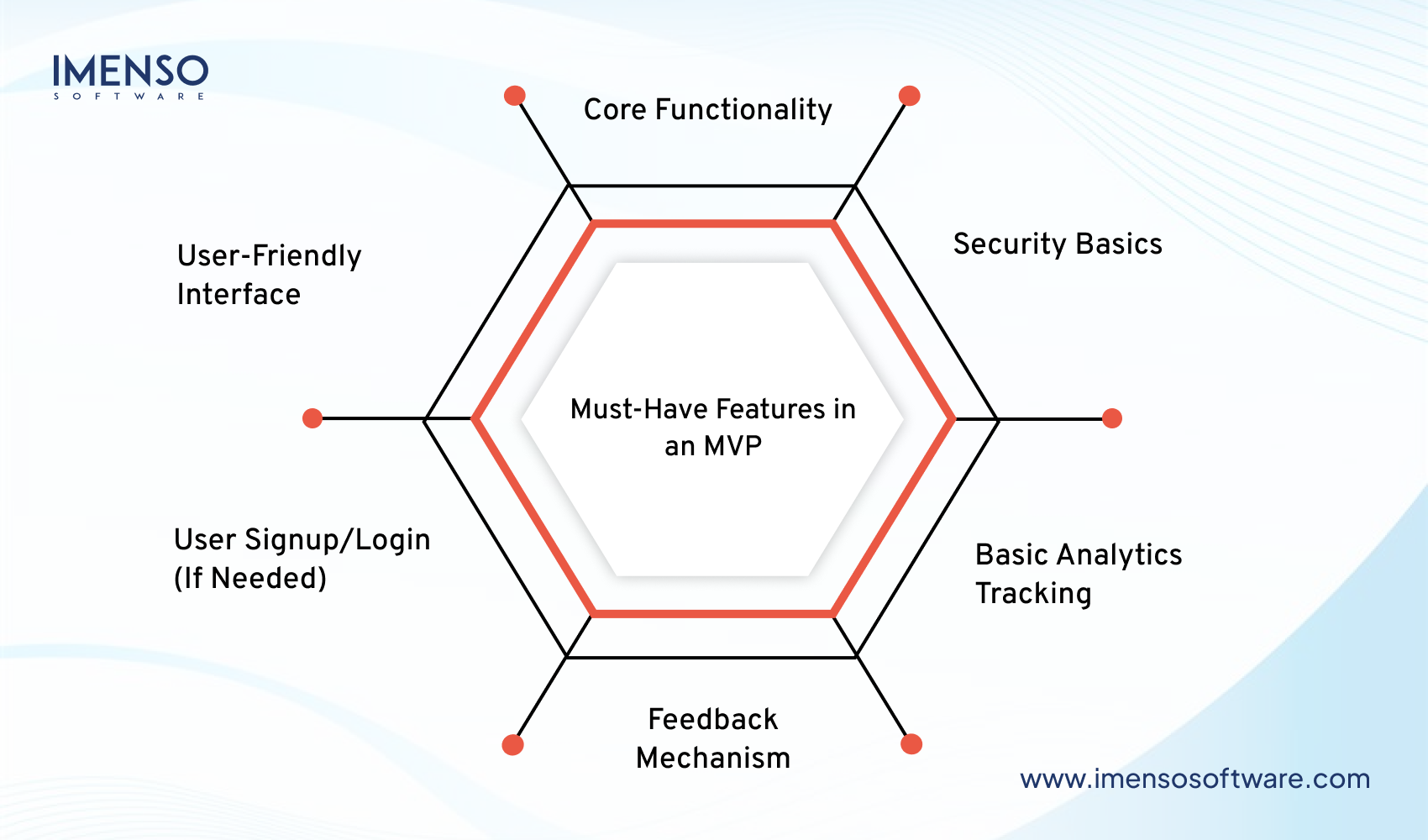
- Core Functionality
Build the one feature that solves your user’s biggest problem. Forget the fluff, just nail the thing your app promises to do best. - User-Friendly Interface
Even a basic MVP should look and feel clean. First impressions matter, don’t ship something clunky and confusing. - User Signup/Login (If Needed)
If your app requires user tracking or saved preferences, include a simple login system (email or social login is fine). - Feedback Mechanism
Give users a way to share what they liked, didn’t like, or wish they had. Think: thumbs up/down, survey links, or even just a chatbot. - Basic Analytics Tracking
You can’t improve what you can’t measure. Add tools like Google Analytics or Mixpanel to learn how people use your MVP. - Security Basics
Even a prototype should handle data responsibly. Use SSL, secure APIs, and encrypted storage for any sensitive information.
And, Skip These for Now
- → Fancy onboarding walkthroughs.
- → Multiple user roles or tiers.
- → Payment integrations (unless core to your value).
- → Custom-built CMS or admin panels.
- → Any feature that doesn’t help prove your idea.
| 💡 Pro Tip
MVP = Minimum Viable, not Barely Working. It should feel reliable, but not be bloated. |
MVP Outsourcing Checklist
Before you sign that contract or make your first payment, run through this list to avoid costly mistakes:
MVP Outsourcing Pre-Launch Checklist:
- Did you research the agency on Clutch, GoodFirms, or UpCity?
- Have they built MVPs in your industry or similar vertical?
- Did you speak with past clients or review case studies?
- Did they pass a small test task or pilot project?
- Are they responsive and clear in communication?
- Do they offer post-launch support?
- Is the contract clear about ownership and NDA?
- Did you discuss timelines, tech stack, and tools?
- Do they allow feedback loops and feature iterations?
- Do they understand your users and product-market fit?
You are on the right track if you answered yes to most of these!
Build Smart MVP From Start
Outsourcing your MVP development can be one of the smartest decisions you make. So, focus on must-have features and watch for red flags while you are doing your MVP development. It would help you launch faster, learn more, and spend less.
Keep in mind that your MVP is not the final product. It’s a real-world test to validate your idea and attract early users also pitch to investors with confidence.
- 🟌 Take your time.
- 🟌 Ask the tough questions.
- 🟌 Trust your instincts and the data.
The right partner will not only build your MVP, but also believe in your vision!
Frequently Asked Questions (FAQs)
-
What’s the best country to outsource MVP development?
Countries are popular due to skilled talent, affordable pricing, and time zone flexibility. Look for teams with proven startup experience, not just cost savings.
-
How much does it cost to outsource MVP development?
It can range from $10,000 to $50,000+ depending on the requirements. MVPs with core functionality can often be built for under $25,000 by offshore teams.
-
Should I choose a freelancer, agency, or dev shop?
- Freelancers are cheaper, but risky if they vanish.
- Agencies offer full support, but can be pricey.
- Small dev shops are a sweet spot, agile, skilled, and cost-effective.
-
How long does an MVP take to build?
On average, 6–12 weeks is standard for a lean MVP. Rushing usually leads to bugs or poor UX.
-
What if my MVP fails?
That’s part of the process! MVPs are meant to test and learn. A failed MVP often gives you the data to pivot into something better.
-
Should I worry about IP theft when outsourcing?
Yes, always sign an NDA and include IP clauses in your contract. Make sure the code and designs along with user data are legally yours.
Want more information about our services?
Similar Posts

Can Laravel be used for building Enterprise Apps?
Laravel has emerged as one of the most popular PHP frameworks for building enterprise apps. There are several reasons that contribute to the popularity of the Laravel framework for enterprise apps. Many of the large businesses found it suitable for building their enterprise apps....

Magento vs WooCommerce vs Shopify vs OpenCart
Into the Dilemma of Picking the Right E-Commerce Platform- Magento vs WooCommerce vs Shopify vs OpenCart? What is the appeal of a pre-built E-Commerce platform? The moment you begin to nurture the idea of your online store, a struggle invades your path. Should you hire web developers and get a brand new website made? Or, […]...

8 Reasons to Outsource Software Product Development
Software product development doesn’t have to be done in-house, and some of the largest companies in the world prefer outsourcing. It simplifies matters and makes it easier for those who want to focus on other aspects of their business....
